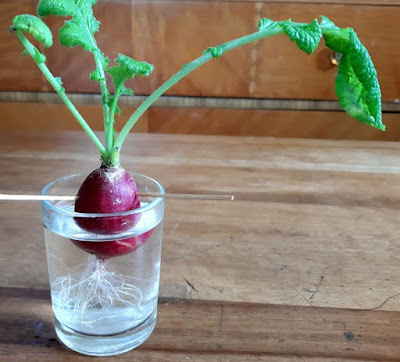Children in kindergarten, first grade, and second grade learn about the parts
of plants and food that come from plants. They learn about the roots,
stems, leaves, seeds, and flowers and the function of each of these
parts. Quite often children... and sometimes adults... are surprised to
find out that the radishes we eat don't just come from a plant... they are
actually a part of the plant! This quick blog post will give you the
directions you need to plant a radish in the classroom and watch it transform
into a full plant.
Learning About Radishes
Radishes are a special kind of root called a tuber. Not only can
you eat radishes raw, you can also eat them roasted, toasted, grilled, and
pickled. Radishes are full of vitamin C and contain smaller amounts of
potassium, calcium, magnesium, vitamin B6, and vitamin K. They are also
a good source of fiber.
To Grow Radishes from Scraps, You Will Need:
- one radish, whole with stems and leaves removed
- three toothpicks
- small glass or plastic cup
- water
Step One
Take your radish and stick three toothpicks into it. Place
the radish on the rim of the glass. Adjust the toothpicks as
needed.
After the first day, a few small root hairs are starting to show.
Step Two
Pour water into the glass, but do not fill it all the way. Leave the top
part of the radish poking out of the water. If you cover the entire radish,
it will drown. Put the jar in a sunny window and wait. Add more water as
needed. In a week or so, you should see some roots and leaves starting
to grow!
After two weeks, the radish has filled the glass with roots.
Step Three
Once the radish starts to grow roots and leaves, it is important to
transfer it to a flower pot. At this point, the plant needs the
nutrients that are found in the soil. Keep the radish plant in a warm,
sunny window and water as necessary. If you care for your radish plant
properly, it could grow to be 18 inches or taller!
Important Note
If you are planting your radish at home, keep it out of your pet's
reach. I transplanted the radish into a pot of soil and set it in a
sunny window. One day I woke up and discovered one of my cats had
dug up the radish and eaten the stems, leaves, and roots. All that
was left was a wrinkly, mushy radish and an empty pot of dirt.
Sadly, my growing radishes experiment came to an abrupt... and tragic...
end. RIP, little radish, RIP.
Do you see my cat's little teeth marks?
Kramer, Eater of Radishes
Did you enjoy this post about growing radishes? If so, check out
these blog posts for more children's books and STEM activities about
growing plants:
- Book + STEM: Pumpkin Life Cycle STEM Activity
- STEM: How to Grow Celery from Scraps + STEM Activity
- STEM: What Happens When You Plant Birdseed?
- Craft: How to Make Earth Day Seed Bombs
- Craft: How to Make Seed Paper Hearts
- Book: Charlie Tractor and the Garden by Carrie and Katie Weyler
- Book: Grow! How We Get Food from Our Garden by Karl Beckstrand









